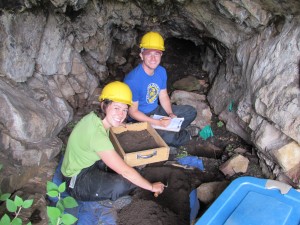
Dr. Jason LaBelle’s Center for Mountain and Plains Archaeology (CMPA) had an active summer, conducting archaeological research in a variety of ecosystems in central and northern Colorado. The crew was composed of Department of Anthropology students, Hallie Meeker, Aaron Whittenburg, and Kelton Meyer, alumna Michelle Dinkel, with Julia Kenyon joining the crew later in the summer.
In June, the field crew traveled to Eagle County where they surveyed two wilderness study areas situated between the Colorado River and Castle Peak. This work was supported by a grant from the Bureau of Land Management. The crew recorded twelve Native American archaeological sites, with sites dating between 8,000 years ago and the last century, as evidenced by the discovery of a metal arrow point. Later in the summer, the crew then traveled to the upper Poudre river canyon to test two rock shelters, as well as several lithic scatters. The crew was assessing the sites’ potential for preservation on the National Register of Historic Places.
In early August, the crew gathered on top of Rollins Pass, along the Continental Divide. Their campsite was situated a little over 11,000 feet above sea level. At Rollins, they continued (since 2010) their survey efforts on one of the most extensive prehistoric hunting systems in North America. The crew recorded prehistoric hunting blinds, walls, and cairns, some of which will be included in Aaron Whittenburg’s forthcoming MA thesis.
As the summer sun raced towards the upcoming fall season, the crew ventured to Rocky Mountain National Park for a final field session. Supported by a grant from the National Park Service, three crews surveyed thirteen melting ice patches located in the Mummy Range, along Trail Ridge Road, and near Mt. Ida and the Continental Divide. Thirteen people participated in this work, including a large number of student volunteers from the CSU Department of Anthropology. The crews mapped a variety of animal bones and wood melting out of these ice patches and surveyed for associated archaeological sites.
